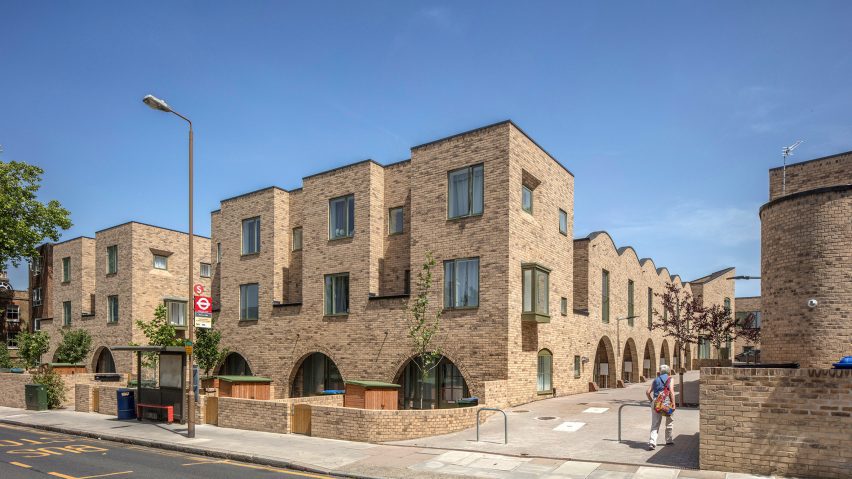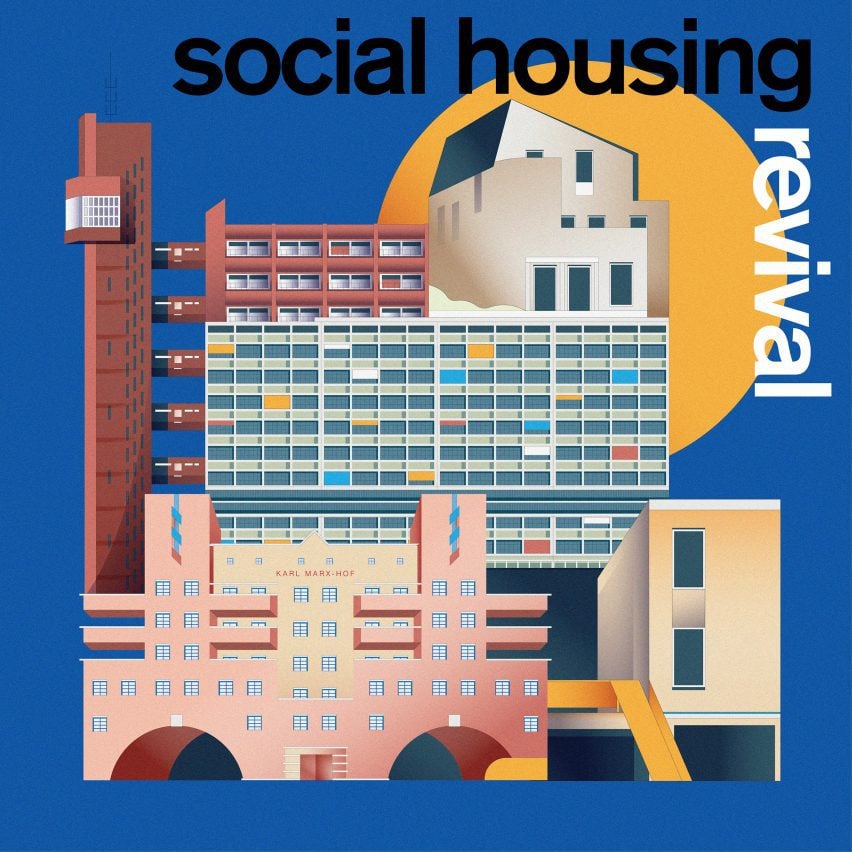
"Social housing has become a matter of enclaves and micro-sites"
Peter Barber's architecture proves that providing social housing at scale without making the design mistakes of the past is eminently possible, writes Owen Hatherley as part of our Social Housing Revival series.
Once upon a time, everyone knew how to solve a housing crisis, or at least they thought they did. The solution was quantity. You can see the results of this numbers game, played all around the world in the mid-20th century, in the dun brick towers of the New York City Housing Authority or the prefabricated blocks of suburban Warsaw or Prague.
But if you want a particularly good picture of what that solution looked like at its least architect-driven, good places to begin are the south-east London inner suburbs of Charlton and Woolwich.
Aside from some pretty esplanades of trees, little thought went into communal spaces or public buildings
Almost nobody has tried anything fancy here. From the 1920s until the 1970s, almost every single unit of housing built here was social housing, mostly council housing. In 1924, this was an area of dense, overcrowded terraces without hot water or inside toilets, riddled with damp and vermin, owned by exploitative private landlords. By 1974, it wasn't.
For over 50 years, social housing was the only game in town. Nonetheless, the trend for many decades here too has been away from social housing. Two large housing estates in the area, both erected by the London County Council using prefabricated concrete building systems, have been demolished in the 21st century – the Ferrier Estate in nearby Kidbrooke, and Morris Walk, in Charlton, close to the river. The first was replaced with a mixed development with a net loss of social housing, the latter is still a building site.
So, combined with the general unaffordability of housing for even many middle-class Londoners, this means there's again a serious need for more social housing. The London Borough of Greenwich is now actually building some, and much of it is to the designs of Peter Barber Architects, justly one of the most praised designers of social housing in recent years.
I know the area well; I lived in a 1950s block here for six years. If you'd moved – as I had – from a subdivided space above a shop owned by an unscrupulous landlord, it was a relief to be in a purpose-built flat with plenty of storage, surrounded by green space, with the flat flooded with light: all the result of a basic acknowledgement that housing is meant to be lived in, not profited from (though as a private tenant I was paying around double what many of my neighbours were).
But, aside from some pretty esplanades of trees, little thought went into communal spaces or public buildings. It works, without ever being exciting.
The first thing you notice about Barber's housing here is that it is exciting. This is something to look at and explore, and – unlike the earlier housing – gives something to those who don't already live in it. Barber's buildings at Harvey Gardens in Charlton consist of a courtyard of houses and flats for senior citizens, packed in behind a typically bleak council playground.
Each of these Barber projects is an example of enjoyable, imaginative architecture
It displays a panoply of different formal devices packed into a small space – canted bay windows, barrel roofs, porthole windows, with everything picked out in a pale red brick; and it is extremely dense, especially when compared with the spacious, rangy approach to social housing demonstrated all around it.
Ten minutes walk uphill from here in Charlton Village, literally stuffed into the space behind a car park is Woodmore Mews (pictured), the most fun of these mini-estates. The two little brick towers that greet you between the parked cars are classic examples of Barber's peculiar fusion of early Victorian nostalgia and early modernist nostalgia, like a Constructivist Old Curiosity Shop.
These lead effortlessly into a tiny pedestrian street with a rhythm of heroic arches, in his now-patented Lilliputian Karl Marx Hof manner. Walk another 10 minutes, past the grounds of the old Woolwich Barracks, and you'll come to Sandpit Place, a group of three terraces between a 1970s low-rise vernacular estate and a lone block of 1960s deck-access maisonettes.
It is the nearest of the three to ordinary British housing, but even then, it is unusually imaginative, showing the influence of Victorian Tyneside flats on the firm's work – basically rows of flats that look to the untrained eye like houses, here full of odd little balconies, terraces and bays.
What is clear in all of these compared with the surrounding housing is that a great deal of effort has been made to emphasise quality rather than quantity, at least within a minimal budget. Each of these Barber projects is an example of enjoyable, imaginative architecture, a peculiar response to a peculiar site.
And those sites often are very peculiar indeed, as much of the council housing being proposed and built today in London, after decades of near-zero construction, is a matter of small council enclaves crammed into odd in-between council-owned spaces, often in existing estates. On the site of a car park or a row of garages, on some scraggy space left over after planning, on the site of a closed community centre.
What we need is more than clever little enclaves on the edges of existing estates
These projects demonstrate amply that this is not, contrary to what some campaigners might argue, a bad thing – aside from providing badly needed genuinely affordable housing, each of these projects enlivens the area rather than detracting from it, and the increased density that results doesn't ever feel like overcrowding. But there are only so many places like these.
The housing crisis in London and overheated cities like it is on such a scale that on larger sites – particularly publicly owned ones – social housing should have priority. This has not been the case here, or in other parts of London.
While it might seem walking around the estates of SE7 and SE18 that the free market has done little here, in fact the biggest publicly owned sites, like Morris Walk and the Ferrier Estate, and biggest of all, the enormous riverside site of the old Royal Arsenal arms factory complex, have all gone to developers, who have used them to build mainly market housing.
Social housing has become a matter of enclaves and micro-sites. Because of this, little can really be done in such projects except alleviating the effects of councils' own demolition projects – these three estates put together, for instance, only makes up a small proportion of the amount of council housing lost in the demolition of Morris Walk.
So what we need is more than clever little enclaves on the edges of existing estates – we need big new social housing projects, big enough to clear waiting lists. But then, if council housing became a numbers game again, wouldn't we just expect more of the decent and diverse but basically uninspired and drab architecture that fills the streets and hills of places like Charlton and Woolwich?
This is where Peter Barber's architecture in particular is important. Barber's architecture is, to quote John Peel on the music of The Fall, "always the same, always different". There is a common repertoire of simple forms and straightforward devices, using materials that even the most basic builders can manage, which provide visual interest without needing bespoke components, complex technologies or anything the always-backward British construction industry can screw up. There is a rare mastery of spaces that actually invite walking rather than driving.
Barber's work shows that it's very easy – and even, cheap – to avoid that straggly, vague, anti-urban feeling of some of the council housing built here in those 50 years where this was all that was built. This work proves it is possible to provide mass social housing that achieves both quality and quantity.
Owen Hatherley is a critic and author, focusing on architecture, politics and culture. His books include Militant Modernism (2009), The Ministry of Nostalgia (2016), Modern Buildings in Britain – a Gazetteer (2022) and most recently Artificial Islands (Repeater, 2022).
The photo is by Morley Von Sternberg.

Social Housing Revival
This article is part of Dezeen's Social Housing Revival series exploring the new wave of quality social housing being built around the world, and asking whether a return to social house-building at scale can help solve affordability issues and homelessness in our major cities.